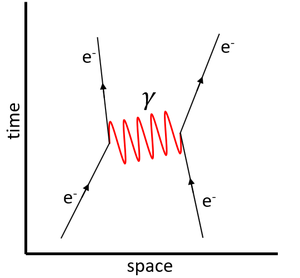Difference between revisions of "Photon"
(→About Photons) |
|||
| Line 50: | Line 50: | ||
<math>f =</math> The [[frequency]] of the [[Electromagnetic Wave|wave]] associated with the '''photon'''. | <math>f =</math> The [[frequency]] of the [[Electromagnetic Wave|wave]] associated with the '''photon'''. | ||
| + | |||
| + | ===Examples=== | ||
| + | {| class="wikitable" | ||
| + | |+The '''virtual photon''' is shown mediating the [[Electromagnetic Interaction|electromagnetic interaction]]. | ||
| + | |[[File:FeynmanDiagramProtonProton.png|center|300px]] | ||
| + | |[[File:FeynmanDiagramElectronElectron.png|center|300px]] | ||
| + | |- | ||
| + | | style="height:20px; width:300px; text-align:center;" |This '''Feynman diagram''' shows the [[Electromagnetic Interaction|electromagnetic interaction]] between two [[proton]]s via the virtual [[photon]]. | ||
| + | | style="height:20px; width:300px; text-align:center;" |This '''Feynman diagram''' shows the [[Electromagnetic Interaction|electromagnetic interaction]] between two [[electron]]s via the virtual [[photon]]. | ||
| + | |} | ||
Revision as of 09:50, 1 August 2019
Contents
Key Stage 5
Meaning
Photons (\(\gamma\)) are bosons responsible for mediating the electromagnetic interaction and are the particle associated with electromagnetic waves.
About Photons
- The photon is denoted with the lower case Greek letter \(\gamma\) (gamma).
- Photons carry energy from one place to another.
- Photons have no mass or charge
About Virtual Photons
- Virtual photons a model for the mechanism of action of the electromagnetic interaction, but they are not strictly 'real'.
- Virtual photons have no mass and therefore can mediate the electromagnetic interaction over an infinite range.
- Virtual photons carry momentum without carrying mass and are therefore able to change the direction of motion of other subatomic particles.
- Virtual photons do not carry charge, but allow particles with charge to exchange momentum.
Equations
Momentum of a Photon
\(p = \frac{h}{\lambda}\)
Where
\(p =\) The momentum of the photon.
\(h = \) Planck's Constant (\(6.63\times10^{-34}Js\)).
\(\lambda =\) The wavelength of the wave associated with the photon.
Energy of a Photon
\(E = hf\)
Where
\(E =\) The energy of the photon.
\(h = \) Planck's Constant (\(6.63\times10^{-34}Js\)).
\(f =\) The frequency of the wave associated with the photon.
The Speed of Light
\(c = f\lambda\)
Where
\(c =\) The speed of light (\(3.00\times10^{8}ms^{-1}\) in a vacuum).
\(\lambda =\) The wavelength of the wave associated with the photon.
\(f =\) The frequency of the wave associated with the photon.
Examples
| This Feynman diagram shows the electromagnetic interaction between two protons via the virtual photon. | This Feynman diagram shows the electromagnetic interaction between two electrons via the virtual photon. |

